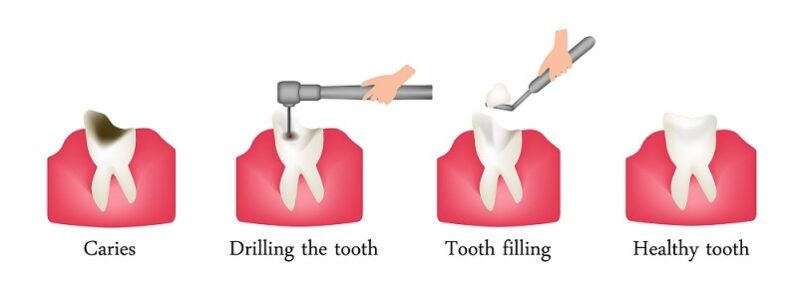Dental Filling
A dental filling is a restorative dental procedure used to repair a tooth that has been damaged by decay or trauma. The process involves removing the decayed or damaged portion of the tooth and filling the resulting cavity with a suitable material to restore the tooth’s function and prevent further decay.
Here are some key points about dental fillings:
-
Purpose: Dental fillings are primarily used to treat dental cavities caused by tooth decay. They help to restore the shape, strength, and function of the affected tooth, preventing the decay from progressing and protecting the tooth from further damage or infection.
-
Procedure: The dental filling procedure typically involves the following steps:
-
Numbing the area: The dentist administers a local anesthetic to numb the tooth and the surrounding area to ensure a pain-free experience.
-
-
-
Removal of decay: The dentist uses a dental drill, laser, or other dental instruments to remove the decayed or damaged portion of the tooth, creating a clean and healthy environment for the filling.
-
Tooth preparation: The dentist shapes the cavity by removing any remaining debris or weakened tooth structure. The cavity is usually shaped to create retention for the filling material.
-
Filling material placement: The dentist selects an appropriate filling material based on factors such as the location of the cavity, the extent of the damage, and the patient’s preference. Common filling materials include amalgam (silver-colored), composite resin (tooth-colored), porcelain, and glass ionomer.
-
Filling placement and shaping: The chosen filling material is placed into the prepared cavity and shaped to resemble the natural contours of the tooth. The dentist ensures that the filling is properly positioned and adjusts the shape and bite as needed.
-
Finishing and polishing: Once the filling material is in place, the dentist smoothes and polishes the filling to improve its appearance, bite, and texture.
-
-
Types of dental fillings: There are several types of dental filling materials available, each with its advantages and considerations:
-
Amalgam fillings: These are made from a combination of metals, including silver, mercury, tin, and copper. Amalgam fillings are strong, durable, and cost-effective. However, their silver color makes them more noticeable, and some individuals have concerns about the mercury content (though amalgam fillings have been deemed safe by numerous dental and health organizations).
-
Composite fillings: These tooth-colored fillings are made from a mixture of resin and glass or quartz particles. They blend with the natural tooth color, providing a more aesthetically pleasing result. Composite fillings bond chemically to the tooth structure, and less healthy tooth structure needs to be removed during placement. However, composite fillings may be less durable and more prone to staining or chipping compared to amalgam fillings.
-
Porcelain fillings: Also known as inlays or onlays, these fillings are custom-made restorations that are fabricated in a dental laboratory and then cemented onto the prepared tooth. Porcelain fillings offer excellent aesthetics and durability, making them a popular choice for visible teeth or larger restorations. They are more expensive and require multiple visits for placement.
-
Glass ionomer fillings: These fillings are made from a mixture of acrylic and glass powders and release fluoride to help prevent decay. They are often used for smaller fillings, as well as fillings on root surfaces or in baby teeth. Glass ionomer fillings have a more limited lifespan and are not as durable as amalgam or composite fillings.
-
-
Aftercare: After a dental filling, it is normal to experience some sensitivity to hot or cold substances for a few days. Proper oral hygiene practices, such as brushing twice a day.





